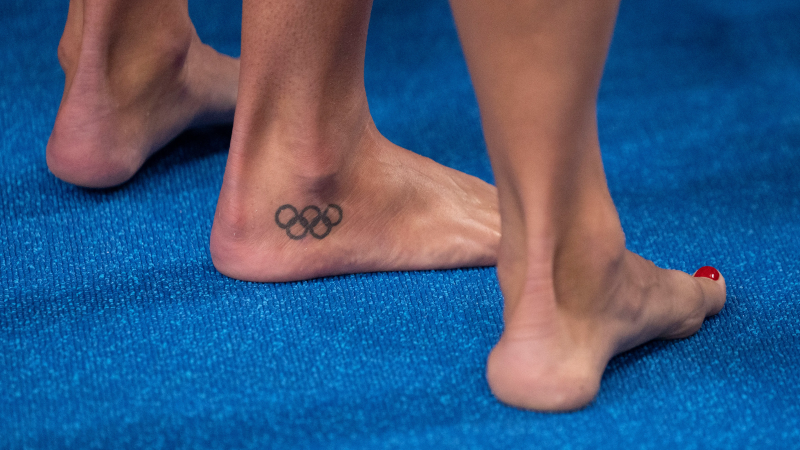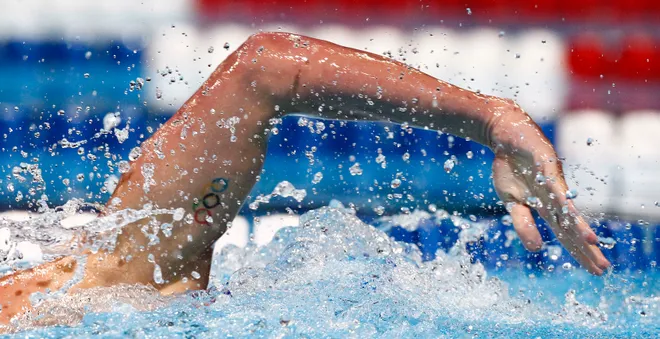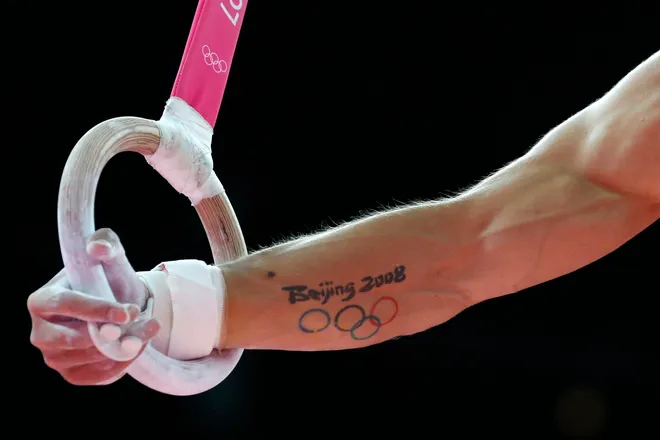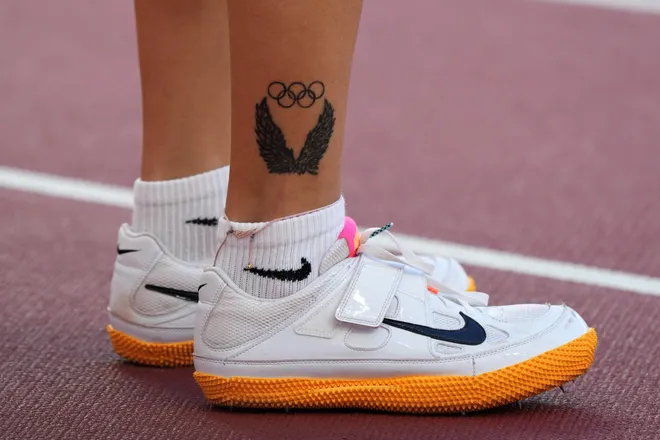Inside the tradition of Olympic rings tattoos and why it's an 'exclusive club'
Nevin Harrison had been an Olympic gold medalist for less than a month when she decided to get her very first tattoo − the iconic symbol of five interlocking rings, stenciled into the side of her left wrist. She said the inches-wide piece cost a whopping $500. She's pretty sure she got ripped off, but she has no regrets.
"I had no idea what I was doing," said Harrison, who won the women's 200-meter canoe sprint at the 2021 Tokyo Games. "I just wanted to get the best one and have perfect circles."
Harrison said she got the Olympic rings tattooed on her wrist in part because that's what she saw so frequently in the Olympic village in Tokyo. She was eager to take part in what's become a well-worn tradition among Olympic athletes, who have been getting tattoos of the rings since long before Harrison, 22, was born.
Over the past two decades, the rings tattoo has become almost ubiquitous at the Summer Olympics − visible on the arms, necks, torsos, ankles and feet of athletes competing across disciplines and in almost every sport. Some go big, with sprawling, colorful and at times ornate versions of the rings that are impossible to miss on TV. Others opt for something smaller, or more subtle. But for most, the mark's meaning is the same. It's an ever-present reminder of the hard work they've put into their craft, and the success they've achieved.
Get Olympics updates in your texts! Join USA TODAY Sports' WhatsApp Channel
Meet Team USA: See which athletes made the U.S. Olympic team and where they are from

"I do think it’s become a rite of passage," said Chris Jacobs, a swimmer who won three medals at the 1988 Summer Olympics in Seoul. "It’s almost like a little card for a somewhat exclusive club."
Jacobs, now 59, is credited with starting the tattoo trend more than 30 years ago. After noticing that a handful of Canadian swimmers, including the late Victor Davis, had small tattoos of the Canadian flag on their chests, Jacobs said his mind wandered to another iconic symbol: The Olympic rings.
So during a trip to Hawaii on his way back from the Seoul Olympics, Jacobs got a small tattoo of the rings on his hip, low enough that it would be hidden by under his swimsuit during competitions. A few years later, he got another one a bit higher up on his hip. Then, after that, he decided to go even bigger − getting a sizable, colored version of the rings drawn on the inside of his right bicep.
"They represent a lot to a lot of people," Jacobs explained. "I wanted to mark that period in my life, I suppose.”
Before long, some of the biggest stars in swimming − including Michael Phelps and Ryan Lochte − were sporting prominent versions of the rings in the pool. And the trend quickly spread to other sports.

Allyson Felix, the most decorated track and field athlete in U.S. history, has the rings inked on her right ankle. Reigning 100-meter world champion Noah Lyles has them on the right side of his rib cage. And each of the past two women's all-around gymnastics champions, Simone Biles and Suni Lee, have them on their wrists.
"It represents just an amazing era of my life," Olympic sprinter Gabby Thomas said. "Whether or not I continued to run and no matter what I did on the track after that, I will always remember this time period and how spectacular it was and how much I've learned and grown from it."
Thomas got a black-and-white version of the rings tattooed on the back of her neck after winning bronze and silver medals on the track in Tokyo. She thought about getting the tattoo in a more prominent spot, or at least one where she could see it. But she decided she didn't want to be constantly looking at it − nor have other people always asking about it.
"What a conversation starter," Harrison said of her tattoo. "There’s Olympic rings on your arm."

Evy Leibfarth, another canoe/kayak athlete, made her Olympic debut in Tokyo at 17 but waited until she turned 18 to get the rings. She always knew she wanted the Olympic ink but couldn't decide on the best spot. "And one day I was just like, (expletive) it, I’m going to go to the shop," Leibfarth said. In a spur-of-the-moment call, she opted for the left side of her torso.
On the opposite end of the spectrum are athletes like Kara Goucher, who didn't get a rings tattoo until 15 years after she first appeared at the Summer Games in 2008. "I felt like I hadn’t performed well there," she wrote on Instagram, noting that her son helped convince her to take pride in being an Olympian.
Ben Hallock, who captained the U.S. men's water polo team in 2021, said he waited seven years. "Just sort of wanted to think about why I was getting it and what it meant to me," he explained.
The tradition has also spilled over to the Paralympics, where several para-athletes have gotten rings tattooed − and then been required by Paralympic organizers to blot it out during competition.
Philip Dorward, a spokesperson for the International Paralympic Committee, wrote in an email that athletes are required to cover any tattoos that could be considered advertising − and the Olympic rings, because they are representative of a competing trademark, meet that definition. (The Paralympic logo is the Agitos, which resemble a trio of swooshes or check marks.)
The USA TODAY app gets you to the heart of the news — fast. Download for award-winning coverage, crosswords, audio storytelling, the eNewspaper and more.

"Even as recent as Rio, the Olympic rings still represented the entire movement," U.S. para-swimmer Jamal Hill explained. "But now, when you come into the Paralympics, if you have Olympic rings tattooed on you, they make you black it out with a sharpie."
Many athletes have started looking for new ways to make the classic rings tattoo their own. Long jumper Tara Davis-Woodhall got "Olympian" written in Japanese, with plans to add a French translation after this summer's Games. U.S. shooter Mary Tucker got a partial sleeve on her right arm, with French irises and Japanese cherry blossoms serving as a backdrop for the rings.
"I think it's so cool how everybody makes their Olympic tattoos their own in a way," said archer Casey Kaufhold, who has an arrow running through the middle of the rings inked on her ankle.
When it comes to Olympic ink, really anything goes − with one notable exception: Superstition dictates that an athlete get the tattoo only after they have actually competed in the Games.
There are horror stories among athletes of those who jumped the gun and then got hurt or sick; Tucker said she knows of at least four athletes who got the tattoo early and then wound up missing the Olympics for one reason or another. She said she tempted fate herself when she scheduled a tattoo appointment for the fall of 2020 then decided not to reschedule it when the Games were postponed by a year, feeling comfortable with the risk because she had long since secured her qualification spot. The North Carolina native wound up winning a team silver medal at the 2021 Games.
"It’s just something to have with you all the times," Tucker said. "It’s one of the most memorable moments of your life, so you want to get reminded of that. And be sure both to remember what you have done, but also stay humble and prepare to do it again."
Contact Tom Schad at tschad@usatoday.com or on social media @Tom_Schad.
Disclaimer: The copyright of this article belongs to the original author. Reposting this article is solely for the purpose of information dissemination and does not constitute any investment advice. If there is any infringement, please contact us immediately. We will make corrections or deletions as necessary. Thank you.







